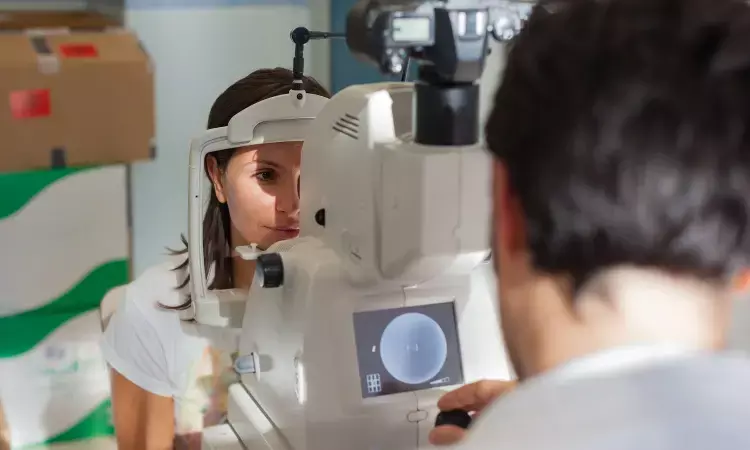- Home
- Medical news & Guidelines
- Anesthesiology
- Cardiology and CTVS
- Critical Care
- Dentistry
- Dermatology
- Diabetes and Endocrinology
- ENT
- Gastroenterology
- Medicine
- Nephrology
- Neurology
- Obstretics-Gynaecology
- Oncology
- Ophthalmology
- Orthopaedics
- Pediatrics-Neonatology
- Psychiatry
- Pulmonology
- Radiology
- Surgery
- Urology
- Laboratory Medicine
- Diet
- Nursing
- Paramedical
- Physiotherapy
- Health news
- Fact Check
- Bone Health Fact Check
- Brain Health Fact Check
- Cancer Related Fact Check
- Child Care Fact Check
- Dental and oral health fact check
- Diabetes and metabolic health fact check
- Diet and Nutrition Fact Check
- Eye and ENT Care Fact Check
- Fitness fact check
- Gut health fact check
- Heart health fact check
- Kidney health fact check
- Medical education fact check
- Men's health fact check
- Respiratory fact check
- Skin and hair care fact check
- Vaccine and Immunization fact check
- Women's health fact check
- AYUSH
- State News
- Andaman and Nicobar Islands
- Andhra Pradesh
- Arunachal Pradesh
- Assam
- Bihar
- Chandigarh
- Chattisgarh
- Dadra and Nagar Haveli
- Daman and Diu
- Delhi
- Goa
- Gujarat
- Haryana
- Himachal Pradesh
- Jammu & Kashmir
- Jharkhand
- Karnataka
- Kerala
- Ladakh
- Lakshadweep
- Madhya Pradesh
- Maharashtra
- Manipur
- Meghalaya
- Mizoram
- Nagaland
- Odisha
- Puducherry
- Punjab
- Rajasthan
- Sikkim
- Tamil Nadu
- Telangana
- Tripura
- Uttar Pradesh
- Uttrakhand
- West Bengal
- Medical Education
- Industry
A new hope for a therapy against retinitis pigmentosa

Retinitis pigmentosa is the most common hereditary retinal disease in humans, with a prevalence of one in every 4,000 people worldwide. The first symptoms usually appear between the ages of 10 and 20 with a loss of night vision. Thereafter, the visual field narrows into a "tunnel vision" to finally lead to blindness around the age of 40. This disease is characterized by a degeneration of the light sensitive cells, the photoreceptors.
These specialized neuronal cells of the retina are responsible for the conversion of light into a nerve signal. The outer segment of the cell is made up of stacks of discs on which the light-sensitive pigments are located. The inner segment contains all the metabolic machinery essential to the functioning of the cell and is linked to the outer segment by the connecting cilium.
A molecular zipper
Mutations in the genes of four proteins located in this connecting cilium are all associated with retinal pathologies presenting degeneration of photoreceptors. These four proteins had been identified by the laboratory of Paul Guichard and Virginie Hamel of the Department of Molecular and Cellular Biology of the Faculty of Science. They are located in centrioles, cylindrical structures made of microtubules and present in all animal cells.
"In the centriole, these proteins ensure the cohesion of the different microtubules by acting like a zipper. We wondered if they did not play the same role in the tubular structures of the connecting cilium," explains Virginie Hamel, last author of the study.
Observations with unprecedented precision
Thanks to an expansion microscopy technique optimized by the group of Virginie Hamel and Paul Guichard, which allow cells to be inflated without deforming them, the scientists were able to observe retinal tissue with a resolution never achieved. The biologists focused on the structure of connecting cilia from mice that had-or did not have-a mutation in the gene for one of the four mentioned proteins. These observations were conducted at different life stages.
"In the absence of the mutation, we found that these proteins ensure, just as we had previously seen in centrioles, the cohesion between microtubules by forming a zipper that closes as development proceeds," explains Olivier Mercey, researcher in the Department of Molecular and Cellular Biology and first author of the study.
On the other hand, when the gene for this protein is mutated, although the structure of the microtubules appears normal in the first days, the microtubules gradually become less and less attached to each other. In adulthood, the affected mice have microtubules that are no longer "zipped" together at all and eventually collapse, leading to cell death of the photoreceptors.
Restoring the "molecular zipper" to prevent cell death
This work, supported by the European Research Council (ERC) and the Pro Visu Foundation, has led to a better understanding at the molecular and structural level of retinitis pigmentosa, which allows to consider therapeutic treatments that act upstream of cell degeneration.
"By injecting the protein into patients suffering from certain types of retinitis pigmentosa, we can imagine that the molecular zipper could be restored to ensure the structural integrity of the microtubules of the connecting cilia, thus preventing the death of photoreceptor cells. We are evaluating this approach in collaboration with our colleagues from UNIL and the Jules-Gonin Ophthalmic Hospital, Yvan Arsenijevic and Corinne Kostic," concludes Paul Guichard, coauthor of the study.
For further reference log on to:
Dr Kamal Kant Kohli-MBBS, DTCD- a chest specialist with more than 30 years of practice and a flair for writing clinical articles, Dr Kamal Kant Kohli joined Medical Dialogues as a Chief Editor of Medical News. Besides writing articles, as an editor, he proofreads and verifies all the medical content published on Medical Dialogues including those coming from journals, studies,medical conferences,guidelines etc. Email: drkohli@medicaldialogues.in. Contact no. 011-43720751


